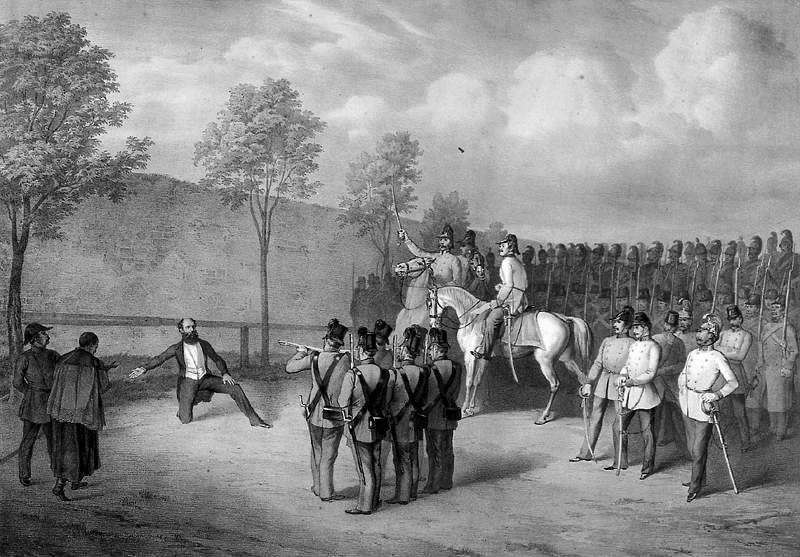Do you know how many Hungarian PMs were executed? – videos

Great-Britain executed one of their kings but none of their Prime Ministers. France executed a king, a queen and a Prime Minister. However, Hungary is somewhere at the top with six executed Prime Ministers. This means that Hungarians put to death almost 11 pc of their PMs. Of course, the situation is not that simple, since in most cases, foreign powers decided.
Not the safest job
One would say that being a PM is tiresome but not too dangerous since a lot of people’s job is only to protect you. However, in Hungary, this is a bit different. Since the country was always in the clash zone of foreign powers, after a military defeat or a change of the regime former decision makers could always found themselves in front of a judge easily.
This is what happened with the first Hungarian Prime Minister, Count Lajos Batthyány. Batthyány became PM after the victory of the Hungarian Revolution of 1848 and resigned short after it, in October, because he saw that a compromise is unrealistic with the Habsburgs. He joined the army as an ordinary soldier but never gave up to
mediate between the government and the Habsburgs.
However, he was not successful and after the Austrian army occupied Budapest, he was taken to Olmütz (now Olomouc, Czech Republic). After the defeat of the revolution in 1849, the military court gave him a prison sentence and confiscated his possessions. However, because of the pressure of the imperial court, his sentence was later modified to death. In fact, he unsuccessfully tried to commit suicide before his execution by cutting his jugular veins with a short sword smuggled into his prison cell by his wife. Therefore, he could not be hanged. He bravely faced the firing squad and shouted: “Long live my country! Come on, huntsmen!”

Communist revenge?
The Hungarian Communists backed by the Soviet Union that occupied Hungary after WWII propagated that the unbelievable destruction of the country was caused by the previous governments. Thus, they
brought to so-called people’s courts all the Prime Ministers they could of the previous era.
Head of the state Miklós Horthy was not extradited by Western authorities like former PM Miklós Kállay and Ferenc Keresztes-Fischer. The former was freed from the Dachau concentration camp while the latter from Mauthausen because of their Anglo-Saxon sympathy. Géza Lakatos was taken to prison in Hungary and questioned many times as a witness in other trials. Pál Teleki committed suicide in 1941.
Béla Imrédy, Lajos Bárdossy, and Döme Sztójay; however, were brought to people’s courts. Imrédy thought that he had a chance for amnesty so he worked on a paper about stopping hyperinflation in his prison cell. Bárdossy knew that he does not have a chance; however, he kept his head cool. Based on his extensive knowledge of the law, economy and languages he argued and debated proving that he is
intellectually above even his judges.
Sztójay – as a known pro-German – was appointed after German troops invaded Hungary in 1944, and gave in to German demands regarding the Hungarian army, the deportation of Jews or legalizing far-right parties. Finally, Ferenc Szálasi was the leader of the fascist Arrow Cross Party and turned Hungary into a client state of Nazi Germany after Regent Miklós Horthy was removed from power during Operation Panzerfaust on 16 October 1944. All four of them were executed in 1945 and 1946. Below you can watch a video about the execution of Szálasi and his ministers:
The Communist PM of the 1956 Revolution
Imre Nagy was a Communist leader who played an active part in destroying democratic Hungarian parties after 1945 and establishing the Communist one-party system in Hungary. Furthermore, he was responsible for the brutal deportation of hundreds of thousands of Germans living in Hungary and as a Minister for Agriculture, he supervised the confiscations of goods from the peasants because of which many were literally
dying from hunger.
However, he was an opponent of the very harsh Rákosi-system, so he became very popular by 1956. After the outbreak of the revolution in 1956, he became PM again and he did not denounce the heritage of the revolution even after its defeat. Because of his popularity, the Kádár-regime considered him as a threat, so after a show trial, he and his co-defendants were executed in 1958. Their reburial in 1989 was an important factor at the end of the communist government in Hungary and where the current Prime Minister, Viktor Orbán showed up in Hungarian politics first. You can watch an excerpt of his speech below:
Photo: commons.wikimedia.org
Source:





